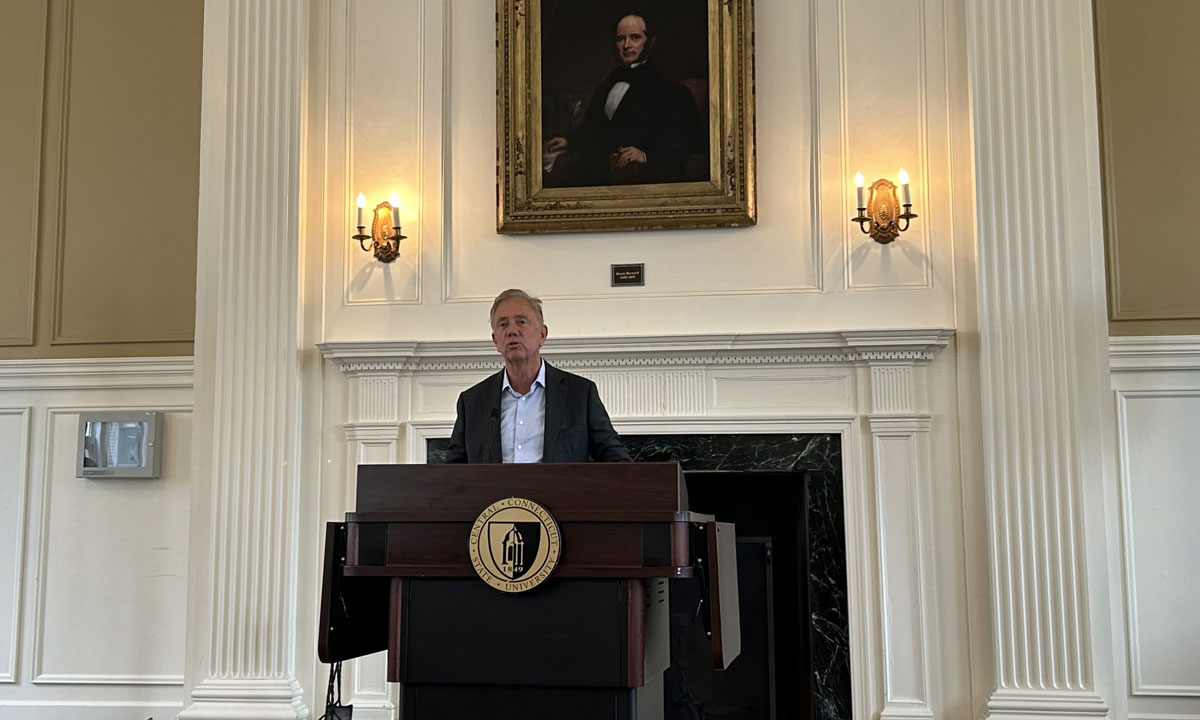Connecticut Invests $3.8M to Expand College-Level Courses in High Schools
Nearly $4 million is being split among the districts, with the majority designated to those that serve high percentages of students of color.

Get stories like this delivered straight to your inbox. Sign up for The 74 Newsletter
Eighty-nine Connecticut school districts will receive thousands of dollars of additional funding to expand their dual credit programs, which offer students both high school and college credit, state officials announced Tuesday morning.
“I think what we’re trying to do with these dual [credit programs], or trying to do with internships, and what we’re trying to do with apprentice programs … is we’re trying to make education real and give it a sense of purpose for young people,” Gov. Ned Lamont said. “[These courses can] give a sneak preview of what happens next, in terms of confidence and sense of direction.”
About $3.8 million is being split among the chosen districts, with most of the funding designated to those that serve high percentages of students of color, including Bridgeport, Danbury, East Hartford, Hartford, New Haven, Norwalk, Waterbury and CREC Magnet Schools, which received $90,000 grants each.
“It’s really about increasing access for all students. I think there are clearly disproportionalities in terms of students of color and students from low-income families, so our grant program that we have launched now is focused explicitly on not just increasing participation but losing those disparities as well,” said Ajit Gopalakrishnan, the chief performance officer for the state’s Department of Education. “The grant program helps with defraying district planning costs and works with institutional direct partners to make the work happen. … Long term, we do need to think about, as a state, supporting the costs involved, even though the costs are minimal for some families.”
Earlier this year, the CT Mirror reported how students of color were being left out of Advanced Placement courses, another type of class that offers college credit if students pass a test at the end of the year. Experts, who said the disparities are often exacerbated in the same classroom or school because of school climate or systemic structures, also said college-level classes could become more equitable by shifting from AP into more dual-credit classes.
Three students interviewed at the time, all recent graduates of Wilby High School in Waterbury, said they weren’t offered dual credit courses at their school.
On Tuesday, Gopalakrishnan said “almost all” high schools “have some availability” of dual-credit courses through partnerships among the education department, individual high schools and UConn and CT State, but was unable to immediately answer how many didn’t offer these classes.
At least 17 schools have suppressed data on the number of students who earned at least three college credits through dual enrollment during the 2022-23 school year, according to state data. Data is typically suppressed for confidentiality reasons because the number of students participating is low.
Wilby was one of those schools.
Other high schools like New Milford High only had seven of 602 upperclassmen, or 1.2%, obtaining at least three college credits through dual-enrollment.
Some schools in districts that are expected to receive funding like Danbury High School, Hartford Public High School and Brien McMahon High School in Norwalk reported under 10% of students were receiving college credit through dual-enrollment.
Meanwhile, in other districts, like Colchester, Weston and Westport, the rate is around 82%.
In Ansonia, where about 40% of the high school’s upperclassmen earned three college credits or more, Superintendent Joseph DiBacco attested to the impact of those courses.
“Just last year, the senior class at Ansonia High School had 900 university credits they acquired,” DiBacco said at the state’s press conference Tuesday.
DiBacco was joined by two students, both of whom said they began taking these courses when they were underclassmen.
“I feel really prepared for college, and I really think that gave me a step forward,” said Paul Palmer, a senior at the high school. “It also saves a lot of money, and that’s my main focus. … I wouldn’t be able to do that without all of these partnerships.”
The state said grant funds are expected to be used mainly for:
- Stipends for high school teachers and college faculty to create course work that lines up with college expectations;
- Tuition reimbursement for high school teachers who need to complete additional training to teach these courses;
- Purchasing additional equipment for fields like health care, technology, etc.;
- Developing strategies to engage more students and explain “the benefits of earning college credit,” including saving money and skipping general education courses.
This story was originally published in CT Mirror.
Get stories like these delivered straight to your inbox. Sign up for The 74 Newsletter

;)